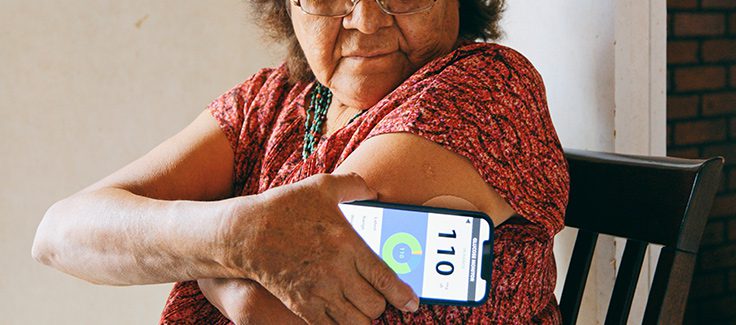Prevalence of Telemedicine and Telehealth in Latin American Hospitals
By: Daniela Chueke Perles
In Latin America, e-health began gradually about fifteen years ago. It developed in a handful of countries until the outbreak of the COVID-19 pandemic, when adoption of telemedicine in response to the restrictions on in-person consultations accelerated.
For more than three billion people, worldwide, access to healthcare (especially during COVID-19) has been challenged by physical distancing, as well as social isolation or quarantine, border closings, restrictions on transportation, and other measures. Wide spread use of information technologies (e.g., cell phones in particular) with high penetration proved to be one of the primary means enabling individuals, governments, and health institutions to work, interact, share information, collaborate, generate knowledge, and communicate with each other. The pandemic became a proving ground for demonstrating the potential of ICTs (information and communication technologies) for health. The two-year pandemic revealed the importance of telemedicine and telehealth to enable and sustain continuity of care services, especially for noncommunicable chronic diseases, and for numerous mental health conditions.
There is a clear trend today among health sector players in the region where introduction of ICTs in general, and particularly for telemedicine, have enormous potential to improve access to, as well as the quality and efficiency of all health systems, with consequent economic and social benefits. This means of access to healthcare is one area that changed radically after the coronavirus, generating unprecedented growth in the sector. That said, telehealth penetration in the region is still slow and has yet to reach its full potential. Some of the concerns that create barriers to the acceleration of telemedicine are a potential breakdown of the relationships between doctors and other professional healthcare workers and patients, compromised quality of care, regulatory issues, and questions about recording accuracy in electronic medical records.
Evolution of Telemedicine Adoption
Today, thanks to telemedicine, remote access to diagnostics and health treatments is a reality for patients in the region. The telehealth solutions operating in Latin American countries are numerous, albeit insufficient; and although the COVID-19 pandemic accelerated adoption of remote health care, there is still a long way to go.
As of 2022, the global telemedicine market is worth more than USD 224 billion. New digital communication channels, developments in artificial intelligence, public policies, and the need for cost savings in health systems are driving growth in the sector, which will reach US$400 billion by 2027.
In Latin America, because of the large distances involved, medical teleconsultations offer the promise of improved access to health for populations farthest away from the nerve centers. This is why the Pan American Health Organization/World Health Organization (PAHO/WHO) supports remote communication through its Virtual Collaboration program by giving training in the knowledge and use of different virtual media and collaborating with those who need to use these media to bring health knowledge to where it is most needed. Internally, to hold remote meetings, the PAHO currently has more than 900 virtual rooms, which its officials use to provide technical cooperation. “With the pandemic, the virtual collaboration model took root at the PAHO, thereby allowing it to meet the needs of the countries, covering activities with most countries in the Americas and the Caribbean,” says Myrna Martí, a specialist in networks, technical cooperation, and associations at the Pan American Health Organization.
Advances in Telemedicine in the Region
When telemedicine began in the late eighties and early nineties, and even into the two thousands, the emerging telemedicine projects in Latin America and the Caribbean were basically individual strategies by either private bodies or professionals trained in computer science who saw the nascent information technologies as tools that could facilitate processes such as remote care, remote diagnostics, or remote assistance in surgical interventions.
As Martí says: “During this period, states had not adopted the use of technologies to facilitate access to health, and they overlooked these initiatives.” Conversely, in recent years, and more significantly when the COVID-19 crisis happened, countries began incorporating these solutions into the development of their health policies and strategies, in order to provide a regulatory framework for their telemedicine projects, to which individual initiatives can subscribe and be included.

Mexico
The National Center for Technological Excellence in Health (CENETEC-Salud), located in Mexico works in the field of telemedicine. This semi-autonomous agency of the Secretariat of Health, designated in 2009 as a WHO Collaborating Center, reports directly to the Undersecretariat for Health Sector Integration and Development.
Created in January 2004, the agency’s mission is to respond to the Mexican health system’s need for systematic, objective information based on the best available evidence about the management and appropriate use of health technologies, in order to inform decision making and optimal use of resources. Its web page can be used to access the Telehealth Observatory of Mexico, a microsite with updated information on the projects being implemented throughout Mexico to provide telemedicine services to different populations. Seven of the country’s federative entities (states) have telemedicine projects: Mexico State, Guerrero, Nayarit, Nuevo León, Querétaro, San Luis Potosí, and Zacatecas. There are other public health institutions, like the Mexican Social Security Institute (IMSS) and the State Social Security and Services Institute (ISSSTE), that currently have telehealth or telemedicine programs running. Some of the National Health Institutes and General Hospitals in Mexico City have also implemented teleconsultation or remote medical-advice service in order to provide continuity of care to patients who need monitoring or follow-up from specialists.
Brazil
One of the most comprehensive and mature telemedicine systems in South America is located in Brazil. RUTE—the University Telemedicine Network—began in 2006, when university hospitals became interconnected through a telemedicine network for primary health care. This program has run for 16 years, with 140 operating units throughout Brazil, and 50 special interest groups (SIGs).
In addition to formally creating telemedicine cores, RUTE supports video conferencing, diagnostic analysis, second opinion, continuous medical education, and web conferences between university hospitals and universities. Its implementation has a scientific, technological, economic, and social impact on existing medical services. This enables adoption of simple, low-cost measures, such as the medical imaging analysis systems with remote diagnostics, which can greatly help reduce the shortage of specialists, as well as facilitate the training and qualification of medical professionals without having to travel to training centers.
At the government level, the Brazil Telehealth Networks Program, a national initiative aimed at improving quality of care in the Single Health System (SUS), is being developed for the entire health system, with remote assistance and remote education. The program began running in 2007 to improve the quality of primary care in the SUS, with positive results at the first level of care: savings in costs and travel times, contact with health professionals in places geographically difficult to access, and speed of service and optimization of resources within the system as a whole, thereby benefiting some 10 million SUS users.
Argentina
Since 1997, the Garrahan Pediatrics Hospital has been developing the country’s first telemedicine program. The project, known as Reference–Counter-reference (Referencia-Contrarreferencia), promotes provincial and regional health centers, and is aimed at providing equal access to consultations with specialist physicians. Since its implementation, 80% of patients have had no need to be moved to the hospital, located in Buenos Aires.
Another pioneering institution in the use of information and communication technologies in health management is Hospital Italiano de Buenos Aires, which has a Health Informatics Department with more than 150 professionals and an Informatic Medicine Residency program for doctors and nurses. This department conducts various telemedicine projects. It is currently evaluating an application for conducting rehabilitation exercises at a patient’s home (telerehabilitation) using movement sensors similar to those used in video game consoles. There is also a synchronous care program (teleconsultations) via videoconferencing between the electronic medical record and the patient portal, and an asynchronous care program for Dermatology.
In terms of diagnostic applications, diagnostic imaging specialists have been doing teleradiology for several years to diagnose test results online away from the hospital. In pathological anatomy, it also provides solutions for online visualization of microscopic slides in operating rooms, in order to consult with experts about surgical decisions precisely when needed.
How will Telemedicine Impact Hospitals?
Telemedicine has the potential to reduce hospitalization times and, through various patient-empowerment strategies, to improve follow-up via remote monitoring of patients and the recording of medication taking (administration), which are two of the problem areas when it comes to discharging patients. From a more general standpoint, if we were to have digital prescribing (i.e., a digitally signed electronic prescription), it would allow practitioners to prescribe from any location, with online validation that the drug is approved by the health authorities, and patients to obtain the medication from their local pharmacy. The entire patient-care cycle benefits from the implementation of information and communication technologies. There are also potential economic benefits from optimizing processes and going paperless.
All that remains now is to discuss what the effects of the advancement of telemedicine will be from an industry standpoint. Will it change the way we do business? Will treatments become more accessible? Will the industry have to explore new development niches, such as health apps or telecare programs? There are many questions to be asked in the hospital-equipment and medical-device industry. The answers will undoubtedly need to be part of key conversations within the sector.
After reviewing the status of telemedicine in the region of the Americas, the PAHO recommends adopting urgent measures to put into practice national telemedicine policies and programs, including the regulatory and strategic framework and the necessary budget, implemented in a holistic and interoperable way, and supported by academic networks, collaboration, and specialized institutions. These policies should generate an enabling context that lends sustainability to the progress achieved, considering the aspects mentioned in the potential barriers.

What’s Next for Telemedicine in Latin America?
To sum up, if the COVID-19 pandemic ultimately demonstrated that the use of digital solutions (primarily low-cost, mass-use ones, which include medical teleconsultations) are a reality and are here to stay. The challenge is to achieve efficient implementations, with providers who know the business and can offer efficient and cost-effective solutions.
In addition, so far this millennium, we have seen a transformation of many paradigms in doctor-patient relations and the provision of health services. The greater proximity that this technology facilitates has shown its potential. Telehealth is gaining momentum, and, if we can produce an institutional and security framework for both professionals and patients, telemedicine will offer numerous good practices and opportunities for training, making it easier for people to access healthcare.
At the same time, full healthcare virtualization is in the future. In-person care is still important for certain medical activities. We will need to take into account the limitations of telemedicine and recognize when face-to-face consultations are necessary.
The central theme of any telehealth policy today must be the impact of its implementation to improve access to health and the patient’s quality of life, in conditions that will always ensure safety, confidentiality, and security of their information, as well as continuity of care, thereby helping to achieve cost-effective universal health access and coverage.
To further facilitate adoption of effective telemedicine in the region, it is clear that, instead of starting from scratch, exchanging successful experiences will help lower costs and barriers to implementation that might otherwise fail as a result of miscalculations. The market in so many parts of the region at both private and public levels is eager for knowledge, as well as proven solutions that save time and money in telemedicine and telehealth implementation. Many of the prestigious hospitals in the United States, Europe, Canada, or other markets could offer their physicians’ expertise to a broader range of patients throughout Latin America.
Next Steps
Customized research from Global Health Intelligence could help your hospital identify both the potential telehealth market and the Latin American hospitals that would be the best partners for this type of initiative. Contact GHI for more information.





